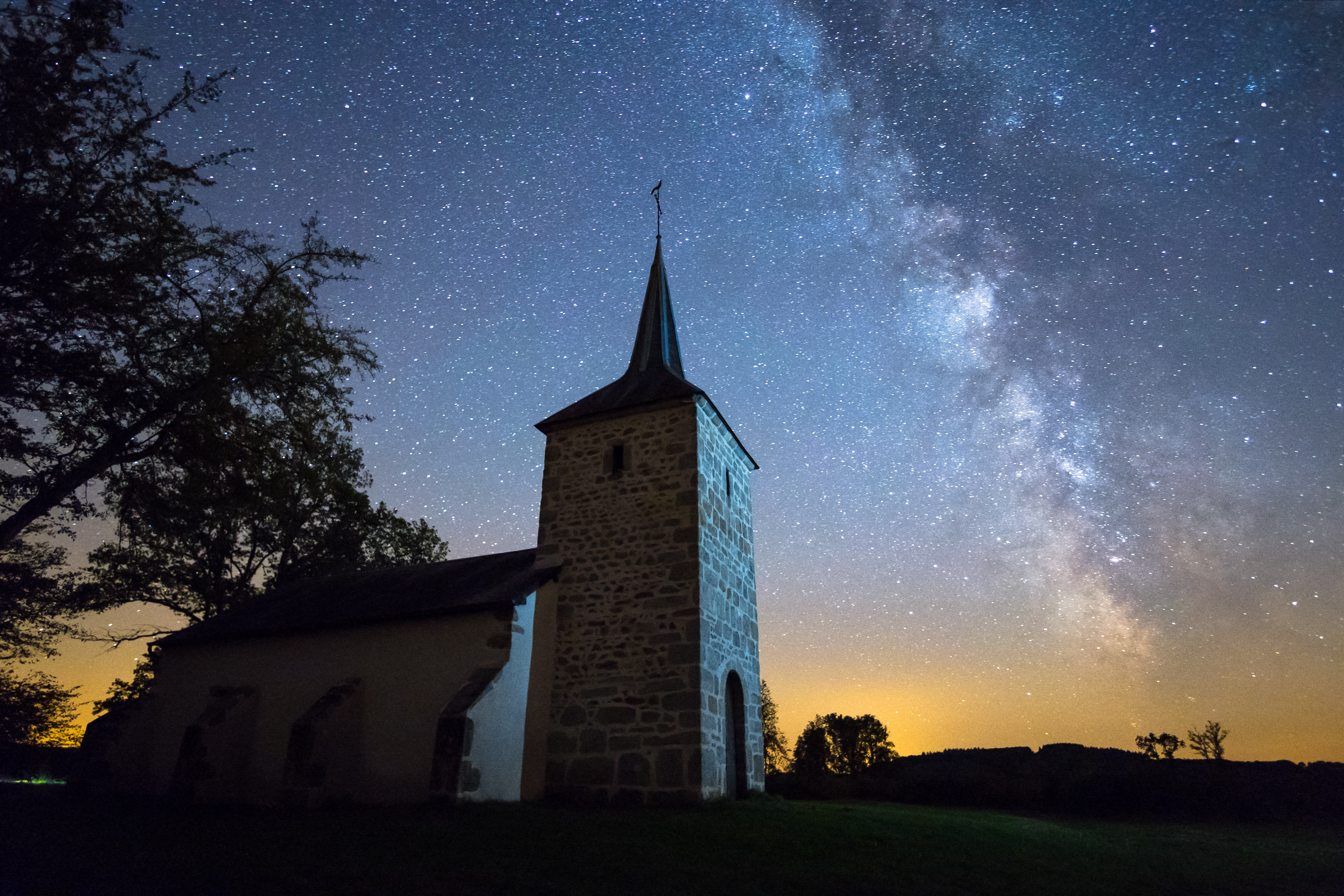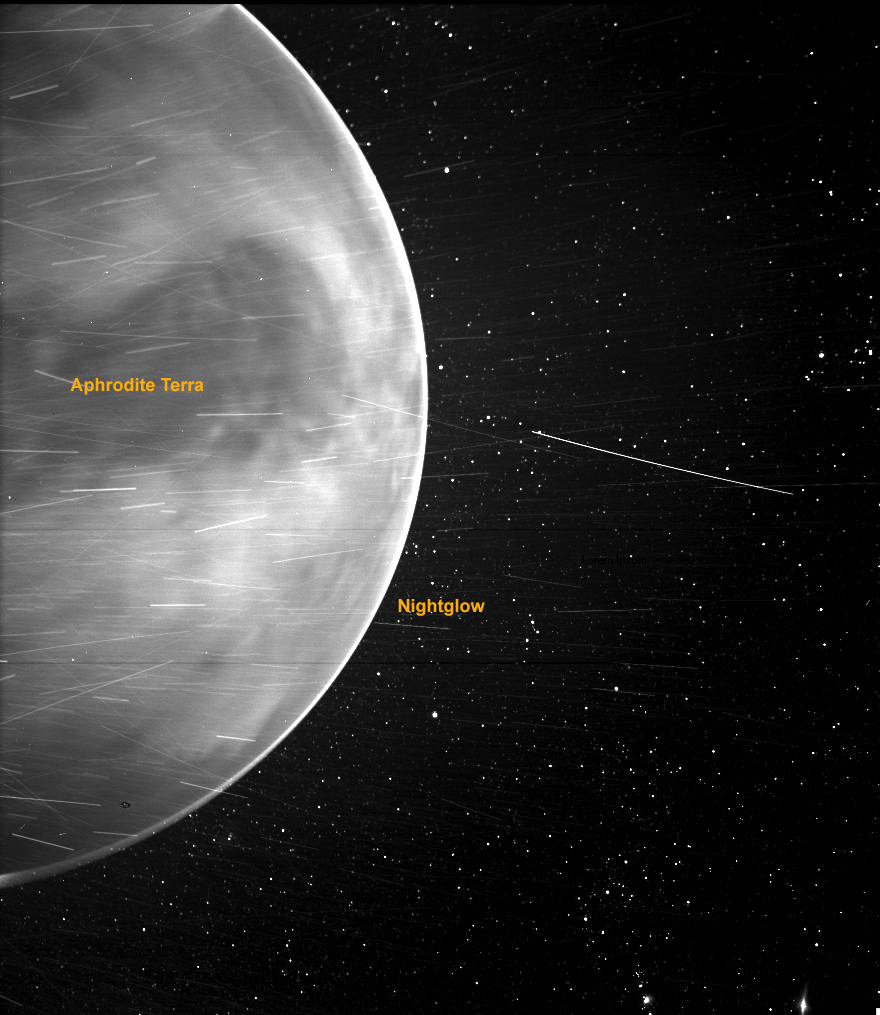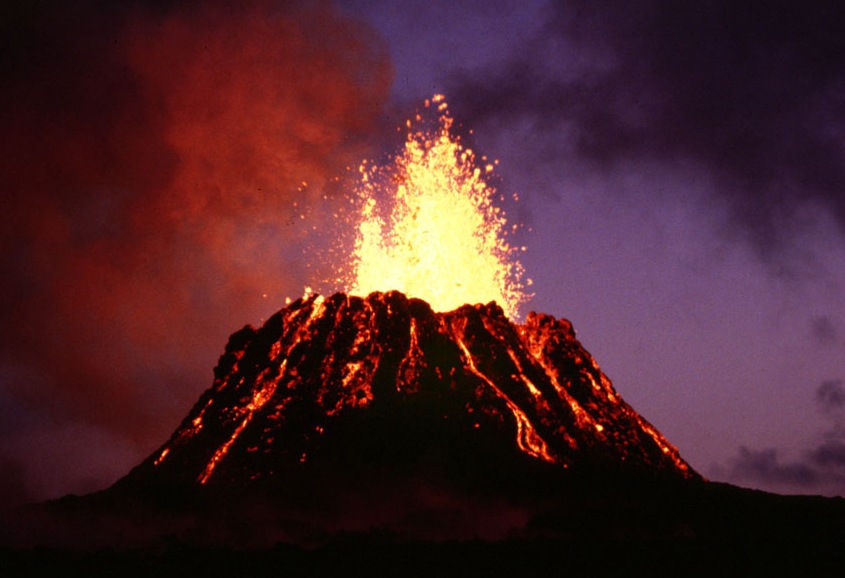|
Earthshine
Earthlight is the diffuse reflection of sunlight reflected from Earth's surface and clouds. Earthshine (an example of planetshine), also known as the Moon's ashen glow, is the dim illumination of the otherwise unilluminated portion of the Moon by this indirect sunlight. Earthlight on the Moon during the waxing crescent is called "the old Moon in the new Moon's arms", while that during the waning crescent is called "the new Moon in the old Moon's arms". Visibility At Earth Earthlight has a calculated maximum apparent magnitude of −17.7 as viewed from the Moon. When the Earth is at maximum phase, the total radiance at the lunar surface is approximately from Earthlight. This is only 0.01% of the radiance from direct Sunlight. Earthshine has a calculated maximum apparent magnitude of −3.69 as viewed from Earth. This phenomenon is most visible from Earth at night (or astronomical twilight) a few days before or after the day of new moon, when the lunar phase is a thin crescent. ... [...More Info...] [...Related Items...] OR: [Wikipedia] [Google] [Baidu] |
Planetshine
Planetshine is the dim illumination, by sunlight reflected from a planet, of all or part of the otherwise dark side of any natural satellite, moon orbiting the body. Planetlight is the diffuse reflection of sunlight from a planet, whose albedo can be measured. The most observed and familiar example of planetshine is earthlight (astronomy), earthshine on the Moon, which is most visible from the night side of Earth when the lunar phase is crescent or nearly new moon, new, without the atmospheric diffuse sky radiation, brightness of the daytime sky. Typically, this results in the dark side of the Moon being bathed in a faint light. Planetshine has also been observed elsewhere in the Solar System. In particular, the Cassini–Huygens, ''Cassini'' space probe used Saturn's shine to image portions of the moons of Saturn, planet's moons, even when they do not reflect direct sunlight. The ''New Horizons'' space probe similarly used Charon (moon), Charon's shine to discover albedo varia ... [...More Info...] [...Related Items...] OR: [Wikipedia] [Google] [Baidu] |
Lunar Phase
A lunar phase or Moon phase is the apparent shape of the Moon's directly sunlit portion as viewed from the Earth. Because the Moon is tidally locked with the Earth, the same hemisphere is always facing the Earth. In common usage, the four major phases are the new moon, the first quarter, the full moon and the last quarter; the four minor phases are waxing crescent, waxing gibbous, waning gibbous, and waning crescent. A lunar month is the time between successive recurrences of the same phase: due to the eccentricity of the Moon's orbit, this duration is not perfectly constant but averages about 29.5 days. The appearance of the Moon (its phase) gradually changes over a lunar month as the relative orbital positions of the Moon around Earth, and Earth around the Sun, shift. The visible side of the Moon is sunlit to varying extents, depending on the position of the Moon in its orbit, with the sunlit portion varying from 0% (at new moon) to nearly 100% (at full moon). Phenomenon ... [...More Info...] [...Related Items...] OR: [Wikipedia] [Google] [Baidu] |
Apparent Magnitude
Apparent magnitude () is a measure of the Irradiance, brightness of a star, astronomical object or other celestial objects like artificial satellites. Its value depends on its intrinsic luminosity, its distance, and any extinction (astronomy), extinction of the object's light caused by interstellar dust along the sightline, line of sight to the observer. Unless stated otherwise, the word ''magnitude'' in astronomy usually refers to a celestial object's apparent magnitude. The magnitude scale likely dates to before the ancient Ancient Greek astronomy#Astronomy in the Greco-Roman and Late Antique eras, Roman astronomer Ptolemy, Claudius Ptolemy, whose Star catalogue, star catalog popularized the system by listing stars from First-magnitude star, 1st magnitude (brightest) to 6th magnitude (dimmest). The modern scale was mathematically defined to closely match this historical system by Norman Robert Pogson, Norman Pogson in 1856. The scale is reverse logarithmic scale, logarithmic: ... [...More Info...] [...Related Items...] OR: [Wikipedia] [Google] [Baidu] |
Moon
The Moon is Earth's only natural satellite. It Orbit of the Moon, orbits around Earth at Lunar distance, an average distance of (; about 30 times Earth diameter, Earth's diameter). The Moon rotation, rotates, with a rotation period (lunar day) that is synchronized to its orbital period (Lunar month#Synodic month, lunar month) of 29.5 Earth days. This is the product of Earth's gravitation having tidal forces, tidally pulled on the Moon until one part of it stopped rotating away from the near side of the Moon, near side, making always the same lunar surface face Earth. Conversley, the gravitational pull of the Moon, on Earth, is the main driver of Earth's tides. In geophysical definition of planet, geophysical terms, the Moon is a planetary-mass object or satellite planet. Its mass is 1.2% that of the Earth, and its diameter is , roughly one-quarter of Earth's (about as wide as the contiguous United States). Within the Solar System, it is the List of Solar System objects by ... [...More Info...] [...Related Items...] OR: [Wikipedia] [Google] [Baidu] |
Night
Night, or nighttime, is the period of darkness when the Sun is below the horizon. Sunlight illuminates one side of the Earth, leaving the other in darkness. The opposite of nighttime is daytime. Earth's rotation causes the appearance of sunrise and sunset. Moonlight, airglow, starlight, and light pollution dimly illuminate night. The duration of day, night, and twilight varies depending on the time of year and the latitude. Night on other celestial bodies is affected by their rotation and orbital periods. The planets Mercury and Venus have much longer nights than Earth. On Venus, night lasts about 58 Earth days. The Moon's rotation is tidally locked, rotating so that one of the sides of the Moon always faces Earth. Nightfall across portions of the near side of the Moon results in lunar phases visible from Earth. Organisms respond to the changes brought by nightfall: darkness, increased humidity, and lower temperatures. Their responses include direct reactions a ... [...More Info...] [...Related Items...] OR: [Wikipedia] [Google] [Baidu] |
Ashen Light
Ashen light (also ''lumière cendrée'') is a hypothesised subtle glow that has been claimed to be seen on the night side of the planet Venus. The phenomenon has not been scientifically confirmed, and theories as to the observed phenomenon's cause are numerous, such as emission of light by Venus, or optical phenomena within the observing telescope itself. A modern hypothesis as to the source of light on Venus suggests it to be associated with lightning, for which there is some evidence on Venus. This theory has fallen out of favour, however, as there is not enough light generated by this lightning so as to be observed. A more recent hypothesis is that it is a form of transient aurorae or airglow caused by unusually high solar activity interacting with the upper Venusian atmosphere. History of observations While the discovery of the ashen light is often attributed to Italian astronomer Giovanni Battista Riccioli, recent evidence finds that German priest Athanasius Kircher might ... [...More Info...] [...Related Items...] OR: [Wikipedia] [Google] [Baidu] |
Starlight
Starlight is the light emitted by stars. It typically refers to visible electromagnetic radiation from stars other than the Sun, observable from Earth at night, although a component of starlight is observable from Earth during daytime. Sunlight is the term used for the Sun's starlight observed during daytime. During nighttime, albedo describes solar reflections from other Solar System objects, including moonlight, planetshine, and zodiacal light. Observation Observation and measurement of starlight through telescopes is the basis for many fields of astronomy, including photometry and stellar spectroscopy. Hipparchus did not have a telescope or any instrument that could measure apparent brightness accurately, so he simply made estimates with his eyes. He sorted the stars into six brightness categories, which he called magnitudes.''Astronomy''. https://d3bxy9euw4e147.cloudfront.net/oscms-prodcms/media/documents/Astronomy-Draft-20160817.pdf: Rice University. 2016. p. 761. - v ... [...More Info...] [...Related Items...] OR: [Wikipedia] [Google] [Baidu] |
List Of Light Sources
This is a list of sources of light, the visible part of the electromagnetic spectrum. Light sources produce photons from another energy source, such as heat, chemical reactions, or conversion of mass or a different frequency of electromagnetic energy, and include light bulbs and stars like the Sun. Reflectors (such as the moon, cat's eyes, and mirrors) do not actually produce the light that comes from them. Incandescence Incandescence is the emission of light from a hot body as a result of its temperature. * * Combustion Lamps * (obsolete) * * * (error) * * * * * *s * (obsolete) * * Other * - shock wave * * * * * * * * * * * * * Nuclear and high-energy particle * * ** ** * * * * * Celestial and atmospheric * Astronomical objects ** Sun (sunlight, solar radiation) *** *** **Star ( Starlight) *** Nova / supernova / hypernova *** **** *** ** *** *** *** *** *** * ** Meteor *** ** *** *Lightning ( Plasma) ** ** ** ** * Luminescence Luminesce ... [...More Info...] [...Related Items...] OR: [Wikipedia] [Google] [Baidu] |
The Power Of EarthLight And The Human Perspective
''The'' is a grammatical article in English, denoting nouns that are already or about to be mentioned, under discussion, implied or otherwise presumed familiar to listeners, readers, or speakers. It is the definite article in English. ''The'' is the most frequently used word in the English language; studies and analyses of texts have found it to account for seven percent of all printed English-language words. It is derived from gendered articles in Old English which combined in Middle English and now has a single form used with nouns of any gender. The word can be used with both singular and plural nouns, and with a noun that starts with any letter. This is different from many other languages, which have different forms of the definite article for different genders or numbers. Pronunciation In most dialects, "the" is pronounced as (with the voiced dental fricative followed by a schwa) when followed by a consonant sound, and as (homophone of the archaic pronoun ''thee'') ... [...More Info...] [...Related Items...] OR: [Wikipedia] [Google] [Baidu] |
Arthur C
Arthur is a masculine given name of uncertain etymology. Its popularity derives from it being the name of the legendary hero King Arthur. A common spelling variant used in many Slavic, Romance, and Germanic languages is Artur. In Spanish and Italian it is Arturo. Etymology The earliest attestation of the name Arthur is in the early 9th century Welsh-Latin text '' Historia Brittonum'', where it refers to a circa 5th century Romano-British general who fought against the invading Saxons, and who later gave rise to the famous King Arthur of medieval legend and literature. A possible earlier mention of the same man is to be found in the epic Welsh poem '' Y Gododdin'' by Aneirin, which some scholars assign to the late 6th century, though this is still a matter of debate and the poem only survives in a late 13th century manuscript entitled the Book of Aneirin. A 9th-century Breton landowner named Arthur witnessed several charters collected in the '' Cartulary of Redon''. The Irish ... [...More Info...] [...Related Items...] OR: [Wikipedia] [Google] [Baidu] |
Moonlight
Moonlight consists of mostly sunlight (with little earthlight) reflected from the parts of the Moon's surface where the Sun's light strikes. History The ancient Greek philosopher Anaxagoras was aware that "''the sun provides the moon with its brightness''". Zhang Heng's treatise "''The Spiritual Constitution of the Universe''" concludes that the light of the moon comes from the Sun. He writes that the Sun and Moon are "like fire and water" where the Sun "gives out light" and the Moon "reflects it". Illumination The intensity of moonlight varies greatly depending on the lunar phase, but even the full moon typically provides only about 0.05–0.1 lux illumination. When a full Moon around perigee (a " supermoon") is viewed around upper culmination from the tropics, the illuminance can reach up to 0.32 lux. From Earth, the apparent magnitude of the full Moon is only about that of the Sun. The color of moonlight, particularly around full moon, appears bluish to th ... [...More Info...] [...Related Items...] OR: [Wikipedia] [Google] [Baidu] |
Inspiration4
Inspiration4 (stylized as Inspirati④n) was a 2021 human spaceflight operated by SpaceX on behalf of Shift4 Payments CEO Jared Isaacman. The mission launched the Crew Dragon Crew Dragon Resilience, ''Resilience'' on 16 September 2021 at 00:02:56 Coordinated Universal Time, UTC from Kennedy Space Center's Kennedy Space Center Launch Complex 39A, Launch Complex 39A atop a Falcon 9 Block 5, Falcon 9 launch vehicle. It placed the Dragon Space capsule, capsule into a low Earth orbit. The mission ended on 18 September 2021 at 23:06:49 UTC, when ''Resilience'' splashed down in the Atlantic Ocean. The trip was the first orbital spaceflight with only private citizens aboard and was part of a charitable effort on behalf of St. Jude Children's Research Hospital in Memphis, Tennessee. Isaacman was named mission commander. The hospital selected two commercial astronauts: cancer survivor Hayley Arceneaux and military veteran Christopher Sembroski. Shift4 selected entrepreneur Sian Proctor, ... [...More Info...] [...Related Items...] OR: [Wikipedia] [Google] [Baidu] |









